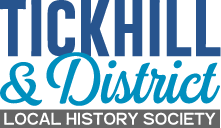

The Red Lion
The Red Lion is the second most popular pub name in England today. There are two accepted derivations of the name: the Red Lion was the personal badge of John of Gaunt, Duke of Lancaster, and began to appear shortly after his death in 1399; it was also the heraldic sign of Scotland and appeared on the royal arms of King James l of England, who, on acceding to the throne in 1603, ordered the Red Lion to displayed on all public buildings. It is difficult to say how long the Red Lion has stood on Market Place (the present building dates back to Georgian times) or which of these two derivations was adopted, but given that John of Gaunt held Tickhill Castle from 1373 until his death in 1399, it is probable that the name relates to the former.
Like so many village inns in the 18th century, along with its traditional function of offering food, drink and shelter to travellers, the Red Lion appears to have been a focal point for community activities. The Tickhill Enclosure Minute Book records it as the venue for a series of meetings held by Commissioners appointed to oversee the implementation of the Tickhill Enclosure Act in 1766. Other early references to its use can be found in the late 18th editions of the Doncaster Gazette: advertisements in the September 1788 notified readers of ‘Tolls to be let [for] Turnpike Bawtry –Tinsley, to be let by auction to the best bidder at the house of Mrs Binge, known by the sign of the Red Lion in Tickhill, Tuesday 30th day of September 1788’. As with many other Tickhill inns, it was also a popular venue for the sale of property and land by public auction. It also appears to have served as a post office as Baines’ 1822 Directory describes the licensee, George Binge as ‘victualler, excise and post office’.
In the early 19th century, the Red Lion was a thriving coaching inn, located on Castlegate, a section of the Tinsley to Bawtry Turnpike Road; it was easily identifiable by its high, wide doorway and large courtyard. It was well-served by mail coaches as the ‘Glasgow Mail’ from London to Glasgow stopped there twice a day, and the ‘Royal Forrester’ and the ‘Light Post Coach’ operated services to Nottingham throughout the week. Other services included the ‘Pelham’ to Lincoln and Sheffield, the ‘Amity’ to Stamford and Doncaster, and the ‘Water Witch’ to Nottingham and Doncaster. Despite the demise of the coaching trade in the mid-19th century, omnibus services to Doncaster, Bawtry and Rotherham continued to operate from the Red Lion until the early years of the of the 20th century.
It seems that ownership was very often kept ‘in the family’: note the above references to ‘the house of Mrs Binge’ in 1788 and to George Binge 34 years later; another instance occurs for a period between the 1830s and 1860s, when the licensee was Thomas Gardiner, followed by his widow, Elizabeth. Other landlords since the late 1860s have included John Shelton, George Staniland, Wilfred James Rawson, Edward Bailey, William Whinfrey, Frank Herbert Higgins and Wilfred Ridgill.
The licensee was responsible for maintaining the good behaviour of his patrons, however this was not always easy as the Register of Licences 1888-1891 reveals: ‘Wilfred James Rawson, the holder of this licence was on 17th October 1891 fined £2.0.0 with £2.4.6 costs for permitting drunkenness’.